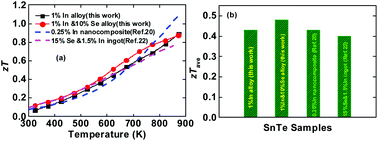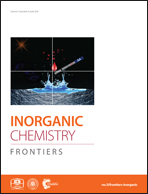Optimization of peak and average figures of merits for In & Se co-doped SnTe alloys†
Abstract
The resonance level leading to the high Seebeck coefficient has been found in indium (In) doped SnTe nanocomposites. In this study, we optimized the doping amount of indium in Sn1−xInxTe alloys under a traditional synthesis process, followed by melting, quenching and the hot-pressing method. On increasing the doping of In, the Seebeck coefficients for all samples increased and the highest power factor of 26 μW cm−1 K−2 at 848 K was obtained for x = 0.25%. Based on the optimized In-doped SnTe composition, which shows the highest thermoelectric figure of merit, Selenium (Se) was introduced as the second doping element to further reduce the lattice thermal conductivity and the cost of raw materials; thus, Sn0.99In0.01Te1−ySey alloys were synthesized. The lowest thermal conductivity of 1.9 W m−1 K−1 at 873 K was observed for the y = 20% sample, which is significantly lower than that for the optimized In-doped sample (2.4 W m−1 K−1). In the end, the 1.00% In-doped SnTe alloy and 1.00% In & 10% Se co-doped SnTe alloy exhibited the highest figures of merit, zT, of ∼0.9 at 873 K. In addition, the highest average figure of merit, zTave, of ∼0.5 was achieved for the 1.00% In & 10% Se co-doped SnTe alloy, which was higher than that of In single-doped nanocomposite and better than that previously reported In & Se co-doped ingot. It is known that a high average figure of merit is preferable in the case of a large temperature difference between the hot and the cold junctions.



 Please wait while we load your content...
Please wait while we load your content...